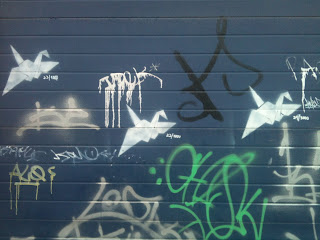I attended a course at Print Club London, a print shop in Dalston with a gallery displaying work on Brick Lane. The course was only 45 quid for an all day course. Being obsessed with artists that mainly use the screen print as their medium I was quite curious to learn more about the process.
The course focused on the photo emulsion method of making a screen print, and started with the students bringing in an image that would eventually be transferred to paper and be our screenprint. Having no artistic talent, and no knowledge of Illustrator, I chose a photographic I took back when I was living in Japan.
To the right you can see the first step of the process, printing the image on a transparent. Well, this is after altering it in Photoshop. For my image I needed to change it to grey scale and do something with the bit map that I didn't quite understand. However, it seemed to have worked out anyway.
 Next, we needed to prepare the screens for printing. We went into a dark room and coated the screens with photo elmusion. A relatively simple process, it was essentially painting the screen with the chemical that would eventually develop under the late table.
Next, we needed to prepare the screens for printing. We went into a dark room and coated the screens with photo elmusion. A relatively simple process, it was essentially painting the screen with the chemical that would eventually develop under the late table.

To the left you can see the screen once the image was exposed on it. This was done by placing the transparent print out on a massive light table and positioning the screen over the transparent. Afterwards, the light table was switched on for about 20 seconds exposing the emulsion and transferring the image to the screen.
 Now it was time to transfer the image from the screen to a piece of paper.
Now it was time to transfer the image from the screen to a piece of paper. We were given our choice of colour and then shown how to load the paint and correctly use the handle to spread the paint evenly over the image.
The first thing we needed to do before applying the paint was register the image. This is shown in the photo to the left. This was essentially lining up the image with the screen so one is able to know where to put the paper so the image is centered and straight. We marked the corners with pieces of tape to aid us once we started transferring to the paper.

After we did that, you can see to the right the process of pulling the paint down across the screen on to the paper. This was repeated 8 times to give us an edition of 8. While the prints were all obviously quite similar small difference can be spotted in the hand pulled screen print due to volume of paint or the angle of the wiper being pulled.
Below, you can see the first screen print I made. An interesting process. The image I choose would've worked better if we could have created a multi-layered screen so I could have added colour to the Geisha's lips and coat which are bright red in the picture (which is the last picture on this post).
All in all a great day of learning one type of way to transfer an image to paper. Only £45 I highly recommend it as a great way to spend a Saturday!
 |
| The drying rack |
 |
| Other students' work |
 |
| The original picture I took in Kyoto. |
















































